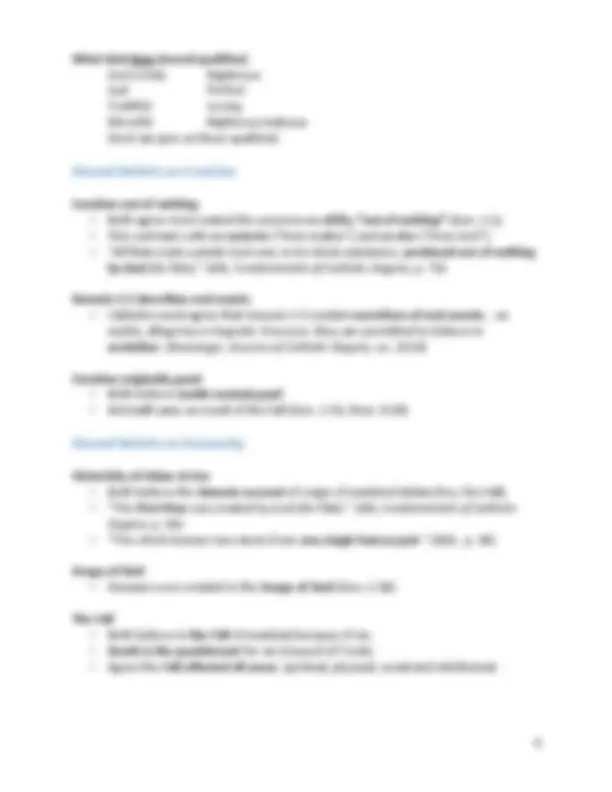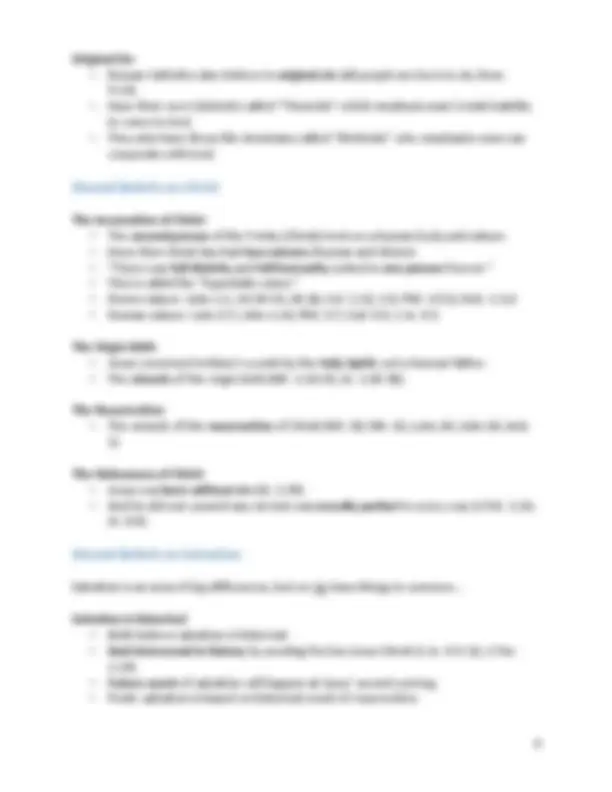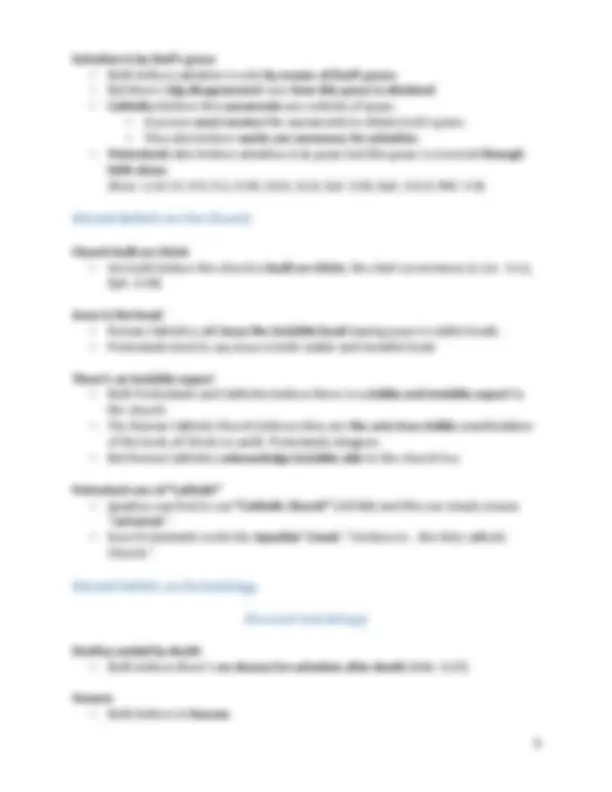Download Comparing Biblical Interpretation & Theological Doctrines: Catholic-Protestant Beliefs and more Exercises Theology in PDF only on Docsity!
May 27 , 201 8
Shared Beliefs between Roman Catholics and Protestants
Recommended Book
- Roman Catholics and Evangelicals: Agreements and Differences by Norman L. Geisler and Ralph E. MacKenzie (Baker Books, 1995).
- James Akin, Roman Catholic, Catholic Answers Senior Apologist “This book offers a comprehensive and balanced discussion and should retire older, sensationalistic works .”
Summary of Agreements
“ What evangelicals have in common with Roman Catholics… this includes the great fundamentals of the Christian faith , including a belief in the Trinity , the virgin birth , the deity of Christ , the creation and subsequent fall of humanity, Christ’s unique atonement for our sins, the physical resurrection of Christ, the necessity of God’s grace for salvation, the existence of heaven and hell , the second coming of Christ, and the verbal inspiration and infallibility of Scripture .” (Geisler, Roman Catholics and Evangelicals , p. 155)
Areas of Agreement
Shared Beliefs on the Bible
High View of Scripture
- “The [Catholic] Church has always venerated the divine Scriptures .” (Vatican II) Scripture is inspired (“from God”)
- Inspiration deals with the source of the Bible : it’s from God (2 Tim. 3:16; 2 Pet. 1:21).
- Prophets were mouthpieces for God (2 Sam. 23:2; Heb. 1:1; Dt. 18:18; “thus says the Lord” x 1700).
- First Vatican Council: The Old and New Testaments were “written under the inspiration of the Holy Spirit … they have God as their author.” Scripture is infallible (“cannot fail or be broken”).
- Jesus said it has divine authority (“it is written,” Mt. 4:7).
- Jesus said it cannot perish (“not on jot or tittle will pass away until all fulfilled,” Mt. 5:17-18)
- Jesus said it cannot be broken (Jn. 10:35). Scripture is inerrant (“without error”):
- Jesus called it true (Jn. 17:17).
- Jesus implied it’s scientifically accurate by affirming creation account and Adam/Eve.
- Jesus implied it’s historically reliable by also affirming Noah, Jonah, Abraham, etc.
- “They [the Scriptures] contain revelation without error... because having been written by the inspiration of the Holy Spirit they have God as their author.” (Vatican I)
Shared Beliefs on God
God’s nature
- Protestants and Catholics hold the same view of God.
- Both affirm the Trinity : there’s one essence of God in 3 distinct persons (Father, Son, Holy Spirit).
- Both deny:
- Tritheism (Father, Son, Spirit are three separate gods).
- Modalism (there’s one God who plays 3 different roles). God’s qualities (attributes)
- Both believe God has two broad categories of qualities.
- God has incommunicable qualities only He Himself has. These are God’s metaphysical qualities.
- God has communicable qualities He gives to His creatures. These are God’s moral qualities. Who God is (metaphysical qualities) God is one Self-existent Infinite Simple Immutable Eternal Omnipresent Omniscient Omnipotent
Original Sin
- Roman Catholics also believe in original sin (all people are born in sin; Rom. 5:12).
- Have their own Calvinists called “Thomists” which emphasis man’s total inability to come to God.
- They also have those like Arminians called “Molinists” who emphasize man can cooperate with God.
Shared Beliefs on Christ
The Incarnation of Christ
- The second person of the Trinity (Christ) took on a human body and nature.
- Since then Christ has had two natures (human and divine).
- “There was full divinity and full humanity united in one person forever.”
- This is called the “hypostatic union.”
- Divine nature: John 1:1; 10:30-33; 20:28; Col. 1:15; 2:9; Phil. 2:5-8; Heb. 1:3,
- Human nature: Luke 2:7; John 1:14; Phil. 2:7; Gal. 4:4; 1 Jn. 4:2. The Virgin birth
- Jesus conceived in Mary’s womb by the Holy Spirit , not a human father.
- The miracle of the virgin birth (Mt. 1:18-25; Lk. 1:26-38). The Resurrection
- The miracle of the resurrection of Christ (Mt. 28; Mk. 16; Luke 24; John 20; Acts
The Sinlessness of Christ
- Jesus was born without sin (Lk. 1:35).
- And he did not commit any sin but was morally perfect in every way (1 Pet. 1:19; Jn. 8:6).
Shared Beliefs on Salvation
Salvation is an area of big differences, but we do have things in common… Salvation is historical
- Both believe salvation is historical.
- God intervened in history by sending His Son Jesus Christ (1 Jn. 4:9-10; 1 Tim. 1:15).
- Future event of salvation will happen at Jesus’ second coming.
- Point: salvation is based on historical event of resurrection.
Salvation is by God’s grace
- Both believe salvation is only by means of God’s grace.
- But there’s big disagreement over how this grace is obtained.
- Catholics believe the sacraments are vehicles of grace.
- A person must receive the sacraments to obtain God’s grace.
- They also believe works are necessary for salvation.
- Protestants also believe salvation is by grace but this grace is received through faith alone (Rom. 1:16-17; 4:5; 5:1; 9:30; 10:4; 11:6; Gal. 3:24; Eph. 2:8-9; Phil. 3:9)
Shared Beliefs on the Church
Church built on Christ
- We both believe the church is built on Christ , the chief cornerstone (1 Cor. 3:11; Eph. 2:20) Jesus is the head
- Roman Catholics call Jesus the invisible head (saying pope is visible head).
- Protestants tend to say Jesus is both visible and invisible head. There’s an invisible aspect
- Both Protestants and Catholics believe there is a visible and invisible aspect to the church.
- The Roman Catholic Church believes they are the only true visible manifestation of the body of Christ on earth. Protestants disagree.
- But Roman Catholics acknowledge invisible side to the church too. Protestant use of “catholic”
- Ignatius was first to use “Catholic Church” (107AD) and this use simply means “ universal .”
- Even Protestants recite the Apostles’ Creed : “I believe in… the holy catholic Church.”
Shared beliefs on Eschatology
(Personal Eschatology) Destiny sealed by death
- Both believe there’s no chance for salvation after death (Heb. 9:27). Heaven
- Both believe in heaven.
Will look at Big Differences Next Week!
Despite having much in common there are big differences. Summary from book: “ …there are some significant differences between Catholics and evangelicals on some important doctrines. Catholics affirm and evangelicals reject the immaculate conception of Mary, her bodily assumption , her role as corredemptrix, the veneration of Mary and other saints, prayers to Mary and the saints, the infallibility of the pope , the existence of purgatory , the inspiration and canonicity of the Apocrypha , the doctrine of transubstantiation , the worship of the transformed Host, the special sacerdotal powers of the Roman Catholic priesthood , and the necessity of works to obtain eternal life.” (Geisler, Roman Catholics and Evangelicals , p. 155)
Bibliography
Geisler, Norman L. Systematic Theology: Volume Four: Church, Last Things. Minneapolis, Minn.: Bethany House, 2002. Geisler, Norman L., and Ralph E. MacKenzie. Roman Catholics and Evangelicals: Agreements and Differences. Grand Rapids, MI: Baker Books, 1995. Ott, Ludwig. Fundamentals of Catholic Dogma. 4th ed. St. Louis: TAN Books and Publishers,
Class Schedule
Overview of Church History May 13: Early Fathers, Theologians and Councils May 20: Events of the Reformation May 27: Shared Beliefs between Roman Catholics and Protestants Jun. 3: Overview of Key Differences Jun. 10: Origin of Denominations Since the Reformation If you know somebody who would be blessed by this class, feel free to invite them; visitors welcome at any time! Where: Sundays second service (10:45AM) in the upstairs chapel building room C-205B














